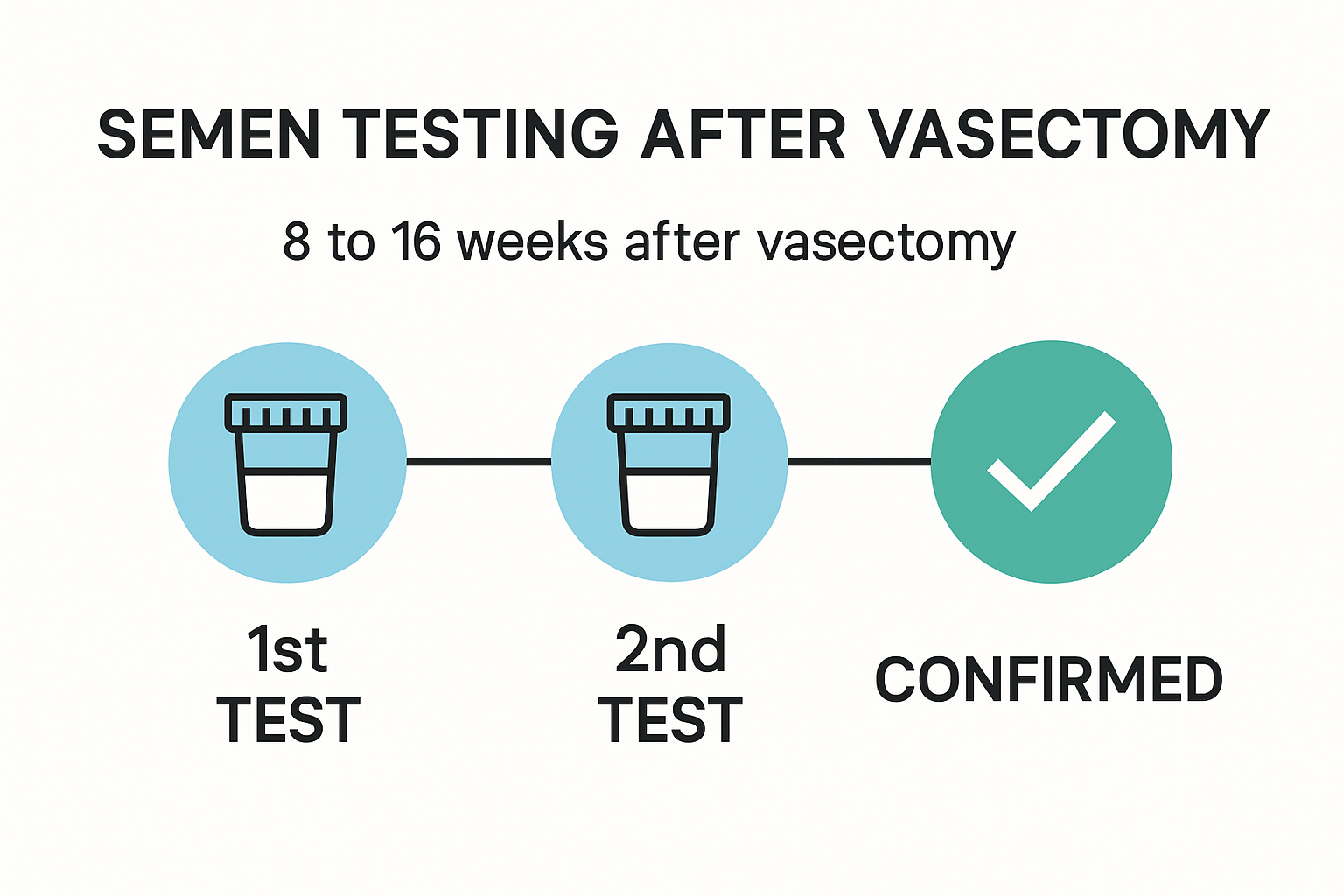Semen testing is a crucial step for men after a vasectomy or when checking fertility health. Here is something you might not expect. Most men need to wait 8 to 16 weeks before their first post-vasectomy semen analysis, and at least two negative tests are required for confirmation. That means a single test is never enough. Every result tells a bigger story about your reproductive journey than you think.
Table of Contents
- Understanding Semen Testing Frequency After Vasectomy
- Recommended Testing Intervals For Fertility And Confirmation
- Factors That Impact Semen Testing Schedules
- Best Practices For Accurate Semen Test Results
Quick Summary
| Takeaway | Explanation |
|---|---|
| Initial Semen Testing Timing | Men should undergo their first post-vasectomy semen analysis between 8 to 16 weeks after the procedure to confirm sterility. |
| Follow-Up Testing Is Essential | At least two negative sperm count tests are recommended to declare a vasectomy fully successful, ensuring thorough evaluation of potential residual sperm. |
| Individual Factors Influence Testing | Age, health status, and individual healing processes can affect semen testing frequency; patients should communicate with healthcare providers for personalized recommendations. |
| Best Practices Enhance Accuracy | Preparing for semen collection includes maintaining sexual abstinence for 2-3 days and avoiding alcohol or caffeine prior to testing to ensure reliable results. |
| Ongoing Monitoring Is Key | Consider semen testing an ongoing process rather than a one-time event to better understand reproductive health and inform decisions about fertility and contraception. |
Understanding Semen Testing Frequency After Vasectomy
Understanding the appropriate semen testing frequency after a vasectomy is crucial for confirming the procedure’s success and ensuring reliable contraception. The post-vasectomy period requires careful monitoring to verify sterility and prevent potential fertility complications.

Recommended Timing for Initial Semen Analysis
The standard protocol for semen testing after a vasectomy involves a strategic approach to timing and evaluation. According to the American Urological Association, men should undergo their first post-vasectomy semen analysis between 8 to 16 weeks after the procedure. This specific timeframe allows sufficient healing and ensures that sperm count has adequately decreased.
The Centers for Disease Control and Prevention strongly emphasizes continuing alternative contraceptive methods until vasectomy success is definitively confirmed through semen analysis. This recommendation underscores the critical nature of comprehensive testing to prevent unintended pregnancies.
Follow-up Testing and Confirmation
Initial testing provides a baseline, but comprehensive confirmation requires multiple assessments. The British Andrology Society recommends that patients produce at least 24 ejaculates before the final assessment. This approach ensures a thorough evaluation of potential residual sperm.
Typical follow-up testing involves analyzing multiple semen samples to confirm complete sterility. Most medical professionals recommend at least two negative sperm count tests before declaring the vasectomy fully successful. Explore our guide on why semen testing is critical to understand the importance of comprehensive post-procedure evaluation.
Understanding Potential Variations
While general guidelines provide a standard framework, individual factors can influence semen testing frequency. Age, overall health, surgical technique, and individual healing processes can impact the timeline for achieving confirmed sterility. Some men might require additional testing or have slightly extended timelines for achieving a zero sperm count.
Patients should maintain open communication with their healthcare provider and follow personalized recommendations. At-home semen testing offers a convenient and discreet method to monitor post-vasectomy status, eliminating the need for multiple clinical visits while providing accurate medical insights.
Remember that patience and thorough testing are key to ensuring the vasectomy’s long-term contraceptive effectiveness. Each step of the semen testing process contributes to confirming the procedure’s success and providing peace of mind.
To help clarify various expert guidelines, the following table summarizes professional recommendations and key requirements for semen testing interval and confirmation:
| Guideline Organization | Initial Testing Timing | Number of Tests Recommended | Additional Requirements |
|---|---|---|---|
| American Urological Association | 8-16 weeks post-vasectomy | At least 2 | Use alternative contraception until confirmed negative |
| British Andrology Society | After 24 ejaculations | At least 2 | Multiple samples for full confirmation |
| Centers for Disease Control & Prevention | 8-16 weeks post-vasectomy | At least 2 | Continue contraception until confirmed |
| American Society for Reproductive Medicine | 1 month apart | 2 | Natural variation considered |
| World Health Organization | 7 days to 3 months apart | 2-3 | Multiple parameters assessed |
Recommended Testing Intervals for Fertility and Confirmation
Semen testing requires a strategic approach to ensure accurate results and comprehensive understanding of reproductive health. The frequency and timing of these tests play a critical role in providing reliable insights for both fertility confirmation and post-vasectomy assessment.
Professional Guidelines for Semen Analysis
Professional medical organizations provide nuanced recommendations for semen testing intervals. The American Society for Reproductive Medicine recommends conducting at least two semen analyses, ideally spaced one month apart. This approach accounts for natural variations in sperm parameters and provides a more comprehensive evaluation.
The World Health Organization suggests performing two to three separate semen analyses with intervals ranging from seven days to three months. This methodology ensures a robust assessment of semen quality and reduces the potential for misleading single-test results.
Factors Influencing Testing Frequency
Multiple factors determine the optimal semen testing schedule. The American Academy of Family Physicians emphasizes maintaining 2-3 days of sexual abstinence prior to each test to minimize daily variations in sperm count and quality. Additional considerations include:
- Age and overall reproductive health
- Previous fertility or medical history
- Specific reproductive goals
- Post-surgical recovery (in cases of vasectomy)
Learn more about comprehensive fertility test kit components to understand the nuanced approach to semen analysis.
Personalized Testing Strategies
While standardized guidelines provide a framework, individual circumstances often require personalized testing strategies. Consulting with a healthcare professional helps determine the most appropriate testing interval based on specific health conditions, age, and reproductive objectives.
At-home semen testing offers a convenient alternative to traditional clinical testing, allowing for more frequent and discreet monitoring. These tests provide flexibility and can complement professional medical assessments, giving individuals greater control over their reproductive health monitoring.
Patients should view semen testing as an ongoing process rather than a one-time event. Regular testing provides valuable insights into reproductive health, helps track changes over time, and supports informed decision-making about fertility and contraception.
Remember that comprehensive semen analysis goes beyond simple sperm counting. Modern testing evaluates multiple parameters including sperm concentration, motility, morphology, and overall reproductive potential. Each test represents a snapshot of reproductive health, with multiple tests offering a more complete picture.

Factors That Impact Semen Testing Schedules
Semen testing is a complex process influenced by multiple interconnected factors that can significantly affect the accuracy and interpretation of results. Understanding these variables is crucial for obtaining reliable insights into reproductive health and fertility potential.
Sexual Activity and Abstinence Patterns
Sexual activity directly impacts semen quality and testing outcomes. The World Health Organization recommends a specific abstinence period of 2 to 7 days, with 2 to 3 days being optimal for accurate semen analysis. This timeframe helps stabilize sperm parameters and provides a consistent baseline for evaluation.
Interestingly, a study published in Reproductive Biology and Endocrinology found that daily ejaculation over a two-week period can influence total sperm count and seminal volume, though it does not significantly alter sperm concentration, motility, or morphology. This research highlights the nuanced relationship between sexual activity and semen characteristics.
Physiological and Health Considerations
Multiple physiological factors can impact semen testing schedules and results. Age, overall health status, underlying medical conditions, and lifestyle choices play critical roles in determining testing frequency and interpretation. Key considerations include:
- Hormonal balance
- Chronic medical conditions
- Medication interactions
- Stress levels
- Nutritional status
- Environmental exposures
Explore detailed insights on semen analysis timing to understand the comprehensive factors influencing reproductive health assessment.
Lifestyle and Environmental Influences
External factors can significantly impact semen quality and testing requirements. The American Urological Association emphasizes that lifestyle choices such as diet, exercise, smoking, alcohol consumption, and exposure to environmental toxins can dramatically affect sperm parameters.
Professionals recommend periodic reassessment based on lifestyle changes or health modifications. At-home semen testing provides flexibility in monitoring these dynamic factors, allowing individuals to track reproductive health more comprehensively and conveniently.
It is essential to recognize that semen testing is not a static, one-time event but a continuous process of understanding reproductive health. Each test provides a snapshot of current conditions, with multiple tests offering a more comprehensive view of potential changes and trends.
Patients should work closely with healthcare providers to develop personalized testing strategies that account for individual physiological characteristics, health history, and specific reproductive goals. The goal is not just to obtain a result but to gain meaningful insights that support informed decision-making about fertility and reproductive health.
To assist in understanding these influences, here’s a summary table highlighting factors that impact semen testing schedules and their specific effects:
| Factor Category | Specific Influences | Effect on Testing/Frequency |
|---|---|---|
| Sexual Activity & Abstinence | Frequency of ejaculation, duration of abstinence (2-7 days) | Alters sperm count and consistency of sample |
| Physiological & Health Factors | Age, health status, hormone balance, chronic conditions | May require adjusted testing intervals/interpretation |
| Lifestyle & Environmental | Diet, exercise, alcohol, smoking, toxin exposure | Can affect sperm quality—may prompt periodic retesting |
| Medications/Medical Interventions | Recent illness, medication changes, surgery | May require rescheduling or additional testing |
| Stress & Emotional Wellbeing | High stress, emotional factors | Can cause temporary fluctuations in results |
Best Practices for Accurate Semen Test Results
Accurate semen testing requires meticulous preparation, precise collection techniques, and careful sample handling. Understanding and implementing best practices can significantly enhance the reliability and interpretability of semen analysis results.
Preparation and Collection Methodology
The World Health Organization provides comprehensive guidelines for optimal semen sample collection. Recommended practices include maintaining a 2-7 day sexual abstinence period, with 2-3 days being ideal for obtaining the most representative sample. This approach ensures consistent sperm parameters and minimizes potential variations.
Key preparation steps include:
- Avoiding alcohol and caffeine 24-48 hours before testing
- Maintaining normal diet and hydration
- Avoiding excessive heat exposure (hot tubs, saunas)
- Managing stress levels
Laboratory Processing and Quality Control
Research published in Reproductive Biomedicine emphasizes the critical importance of standardized laboratory procedures. Implementing rigorous quality control measures ensures the accuracy and reproducibility of semen analysis results.
Professional laboratories follow strict protocols that include:
- Precise temperature management
- Timely sample processing
- Calibrated equipment
- Trained technical personnel
- Consistent analytical methodologies
Discover comprehensive semen test kit instructions to understand the nuanced approach to at-home sample collection and processing.
Multiple Testing and Comparative Analysis
The American Society for Reproductive Medicine recommends conducting at least two semen analyses, ideally spaced one month apart. This approach accounts for natural biological variations and provides a more comprehensive assessment of reproductive health.
Factors that can impact test accuracy include:
- Recent illness
- Medication changes
- Significant lifestyle modifications
- Emotional stress
At-home semen testing offers a convenient alternative to traditional clinical testing, providing individuals with greater flexibility and privacy. However, it is crucial to follow instructions precisely and consult healthcare professionals for comprehensive interpretation.
Patients should view semen testing as a nuanced diagnostic tool. No single test provides a definitive assessment of fertility. Multiple tests, combined with professional medical consultation, offer the most comprehensive understanding of reproductive health.
Remember that accurate semen testing goes beyond simply counting sperm. Modern analysis evaluates multiple parameters including sperm concentration, motility, morphology, and overall reproductive potential. Each test represents a critical snapshot of reproductive health, with careful preparation and processing being key to obtaining meaningful results.
Frequently Asked Questions
What is the recommended timing for the first post-vasectomy semen analysis?
Men should undergo their first post-vasectomy semen analysis between 8 to 16 weeks after the procedure to ensure adequate healing and effectively confirm sterility.
How many semen tests are required to confirm a successful vasectomy?
At least two negative sperm count tests are recommended to declare a vasectomy fully successful, ensuring thorough evaluation of any residual sperm.
What factors can influence the frequency of semen testing?
Factors such as age, overall health, previous fertility issues, and individual healing processes can affect how often semen tests should be conducted.
What best practices should be followed to ensure accurate semen test results?
To obtain reliable semen test results, men should maintain sexual abstinence for 2-3 days before testing, avoid alcohol and caffeine prior to testing, and manage stress levels effectively.
Recommended
- Why Semen Testing Is Critical: Insights for Men and Clinics
- Post Vasectomy Semen Test Timing - Understanding When
- Routine Semen Analysis Benefits for Vasectomy and Fertility 2025
- Semen Analysis and Fertility Planning: Insights for Vasectomy and Conc
- Semen Analysis Timing: Best Practices for Vasectomy and Fertility 2025
- How to Read Semen Results: Vasectomy & Fertility in 2025





